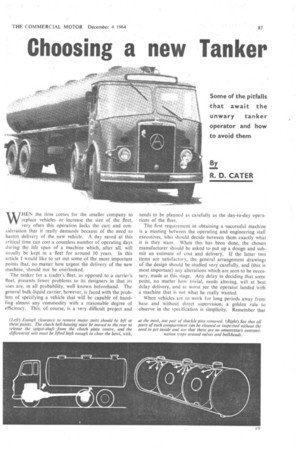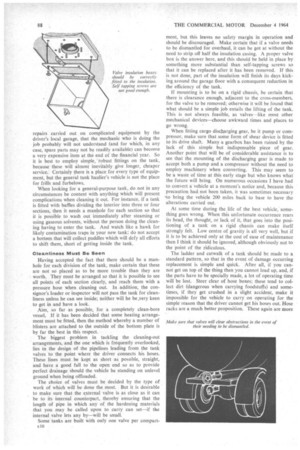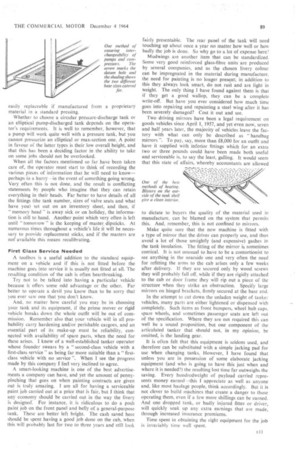Choosing a new Tanker
Page 89

Page 90

Page 91

If you've noticed an error in this article please click here to report it so we can fix it.
By R. D. CATER
WHEN the time comes for the smaller company to replace vehicles or increase the size of the fleet, very often this operation lacks the care and consideration that it really demands because of the need to hasten delivery of the new vehicle. A day saved at this critical time can cost a countless number of operating days during the life span of a machine which, after all, will usually be kept in a fleet for around 10 years. In this article I would like to set out some of the more important points that, no matter how urgent the delivery of the new machine, should not be overlooked.
The tanker for a trader's fleet, as opposed to a carrier's fleet, presents fewer problems to its designers in that its uses are, in all probability, well known beforehand. The general bulk-liquid carrier, however, is faced with the problem of specifying a vehicle that will be capable of handling almost any commodity with a reasonable degree of efficiency. This, of course, is a very difficult project and needs to be planned as carefully as the day-to-day operations of the fleet.
The first requirement in obtaining a successful machine is a meeting between the operating and engineering staff executives, who should decide between them exactly what it is they want. When this has been done, the chosen manufacturer should be asked to put up a design and submit an estimate of cost and delivery. If the latter two items are satisfactory, the general arrangement drawings of the design should be studied very carefully, and (this is most important) any alterations which are seen to be necessary, made at this stage. Any delay in deciding that some point, no matter how trivial, needs altering, will at best delay delivery, and at worst see the operator landed with a machine that is not what he really wanted.
When vehicles are to work for long periods away from base and without direct supervision, a golden rule to observe in the specification is simplicity. Remember that repairs carried out on complicated equipment by the driver's local garage, that the mechanic who is doing the job probably will not understand (and for which, in any case, spare parts may not be readily available) can become a very expensive item at the end of the financial year. So it is best to employ simple, robust fittings on the tank, because these will almost inevitably give longer, cheaper service. Certainly there is a place for every type of equipment, but the general tank haulier's vehicle is not the place for frills and furbelows.
When looking for a general-purpose tank, do not in any circumstances be content with anything which will present complications when cleaning it out. For instance, if a tank is fitted with baffles dividing the interior into three or four sections, then it needs a manhole for each section so that it is possible to wash out immediately after steaming or using gaseous solvents, without the person doing the cleaning having to enter the tank. And watch like a hawk for likely contamination traps in your new tank; do not accept a bottom that will collect puddles which will defy all efforts to shift them, short of getting inside the tank.
Cleanliness Must Be Seen Having accepted the fact that there should be a manhole for each division of the tank, make certain that these are not so placed as to be more trouble than they are worth. They must be arranged so that it is possible to see all points of each section clearly, and reach them with a pressure hose when cleaning out. In addition, the consignor's loader or inspector will not pass the tank for cleanliness unless he can see inside; neither will he be ,very keen to get in and have a look.
Aim, so far as possible, for a completely clean-bore vessel. If it has been decided that some heating arrangement must be fitted, then the method whereby a number of blisters are attached to the outside of the bottom plate is by far the best in this respect.
The biggest problem in tackling the cleaning-out arrangements, and the one which is frequently overlooked, lies in the design of the pipelines leading from the tank valves to the point where the driver connects his hoses. These lines must be kept as short as possible, straight, and have a good fall to the open end so as to provide perfect drainage should the vehicle be standing on unlevel ground when being offloaded.
The choice of valves must be decided by the type of work of which will be done the most. But it is desirable to make sure that the external valve is as close as it can be to its internal counterpart, thereby ensuring that the length of pipe in which any of the hardening materials that you may be called upon to carry can set—if the internal valve lets any by will be small.
Some tanks are built with only one valve per compart ment, but this leaves no safety margin in operation and should be discouraged. Make certain that if a valve needs to be dismantled for overhaul, it can be got at without the need to strip, off half the insulation casing. A proper valve box is the answer here, and this should be held in place by something more substantial than self-tapping screws so that it can be replaced after it has been removed. If this is not done, part of the insulation will finish its days kicking around the garage floor with a consequent reduction in the efficiency of the tank.
If mounting is to be on a rigid chassis, be certain that there is clearance enough, adjacent to the cross-members, for the valve to be removed; otherwise it will be found that what should be a simple job entails the lifting of the tank. This is not always feasible, as valves—like most other mechanical devices—choose awkward times and places to go wrong.
When fitting cargo discharging gear, be it pump or compressor, make sure that some form of shear device is fitted to its drive shaft. Many a gearbox has been ruined by the lack of this simple but indispensable piece of gear. Another point that will be of considerable assistance is to see that the mounting of the discharging gear is made to accept both a pump and a compressor without the need to employ machinery when converting. This may seem to be a waste of time at this early stage but who knows what the future will bring. On numerous occasions I have had to convert a vehicle at a moment's notice and, because this precaution had not been taken, it was sometimes necessary to bring the vehicle 200 miles back to base to have the alterations carried out.
At some time during the life of the best vehicle, something goes wrong. When this unfortunate occurrence rears its head, the thought, or lack of it, that goes into the positioning of a tank on a rigid chassis can make itself strongly felt. Low centre of gravity is all very well, but if it is to be achieved only at the cost of ease of maintenance then I think it should be ignored, although obviously not to the point of the ridiculous.
The ladder and catwalk of a tank should be made to a standard pattern, so that in the event of damage occurring replacement is simple and quick. After all, if you cannot get on top of the thing then you cannot load up, and, if the parts have to be specially made, a lot of operating time will be lost. Steer clear of hose boxes; these tend to collect dirt (dangerous when carrying foodstuffs) and sometimes, if they get crushed in a slight accident, make it impossible for the vehicle to carry on operating for the simple reason that the driver cannot get his hoses out. Hose racks are a much better proposition. These again are more easily replaceable 1 manufactured from a proprietary material in a standard pressing.
Whether to choose a circular pressure-discharge tank or an elliptical pump-discharged tank depends on the operator's requirements. It is well to remember, however, that a pump will work quite well with a pressure tank, but you cannot pressurize an elliptical or max-section one. A point in favour of the latter types is their low overall height, and that this has been a deciding factor in the ability to take on some jobs should not be overlooked.
When all the factors mentioned so far have been taken care of, the operator must start to think of recording the various pieces of information that he will need to know— perhaps in a hurry -in the event of something going wrong. Very often this is not done, and the result is conflicting statements by people who imagine that they can retain everything in their heads. Far better to have details of all the fittings (the tank number, sizes of valve seats and what have you) set out on an inventory sheet, and then, if "memory head is away sick or on holiday, the information is still to hand. Another point which very often is left until tomorrow is the keeping of master, dipsticks. At numerous times throughout a vehicle's life it will be necessary to provide replacement sticks, and if the masters are nor available this means recalibrating.
First Class Service Needed A toolbox is a useful addition to the standard equipment on a vehicle and if this is not fitted before the machine goes into service it is usually not fitted at all. The resulting condition of the cab is often heartbreaking.
Try not to be talked into having a particular vehicle because it offers some odd advantage or the other. Far better to operate a devil you know than to be sorry that you ever saw one that you don't know.
And, no matter how careful you may be in choosing your tank and its equipment, if the prime mover or rigid vehicle breaks down the whole outfit will be out of commission. Remember also that your vehicle will in all probability carry hardening and/or perishable cargoes, and an essential part of its make-up must be reliability, connected with availability of spare parts, when the need for these arises. I know of a well-established tanker operator whose founder swears by a "second-class, vehicle with a first-class service" as being far more suitable than a " firstclass vehicle with no service ". When I see the progress made by this company f feel very. inclined to agree.
A smart-looking machine is one of the best advertisements a company can have, and yet the amount of pennypinching that goes on when painting contracts are given out is truly amazing. I am all for having a serviceable paint job carried out at a price that is fair, but I think that any economy should be carried out in the way the livery is designed: for instance, it .is ridiculous to do a posh paint job on the front panel and belly of a general-purpose tank. These are better left bright. The cash saved here should be spent having a good job done on the cab, when this will probably last for two to three years and still look fairly presentable. The rear panel of the tank will need touching up about once a year no matter how well or how badly the job is done. So why go to a lot of expense here?
Mudwings are another item that can be standardized. Some very good reinforced glass-fibre units are produced by several companies, and as the chosen livery colour can be impregnated in the material during manufacture. the need for painting is no longer present; in addition to this they always look smart, do not ruit and are light in weight. The only thing I have found against them is that if they get a good wallop, they can be a complete write-off. But have you ever considered how much time goes into repairing and repainting a steel wing after it has been severely damaged? Cost it out and see.
Two driving mirrors have been a legal requirement on goods vehicles since April 1, 1957, and yet even now, seven and half years later, the majority of vehicles leave the factory with what can only be described as "handbag mirrors ". To pay, say, more than £8,000 for an outfit and have it supplied with inferior fittings which for an extra two or three pounds could have been made both useful and serviceable is, to say the least, galling. It would seem that this state of affairs, whereby accountants are allowed to dictate to buyers the quality of the material used in manufacture, can be blamed on the system that permits this. And, remember, this is not confined to mirrors.
Make quite sure that the new machine is fitted with a type of mirror that the driver can properly use, and thus avoid a lot of those unsightly (and expensive) gashes in the tank insulation. The fitting of the mirror is sometimes comical. It is not unusual to have to be a contortionist to see anything in the nearside one and very often the need for refitting the arms to the cab arises only a few weeks after delivery. If they are secured only by wood screws they will probably fall off, while if they are rigidly attached to the cab or door frame they will rip out a piece of the structure when they strike an obstruction. Specify large mirrors on hinged brackets, firmly secured at the base end.
In the attempt to cut down the unladen weight of tanker vehicles, many parts are either lightened or dispensed with completely. Such items as front bumpers, wheel hub caps. spare wheels, and sometimes passenger seats are left out of the specification. Where they are not required this can well be a sound proposition, but one component of the articulated tanker that should not, in my opinion, be omitted, is the landing gear.
It is often felt that this equipment is seldom used, and therefore can be substituted with a simple jacking pad for use when changing tanks. However, I have found that unless you are in possession of some elaborate jacking equipment (and who is going to have this just when and where it is needed?) the resulting lost time far outweighs the saving. Every hundredweight of payload carried represents money earned --this I appreciate as well as anyone and, like most haulag people, think accordingly. But it is not clever to build in chines that create a danger to those operating them, even if a few more shillings can be earned. And one dropped tank, or badly injured fitteror driver, will quickly soak up any extra earnings that are made, through increased insurance premiums.
Time spent in obtaining the right equipment for the job is invariably time well spent.
































































































































































































